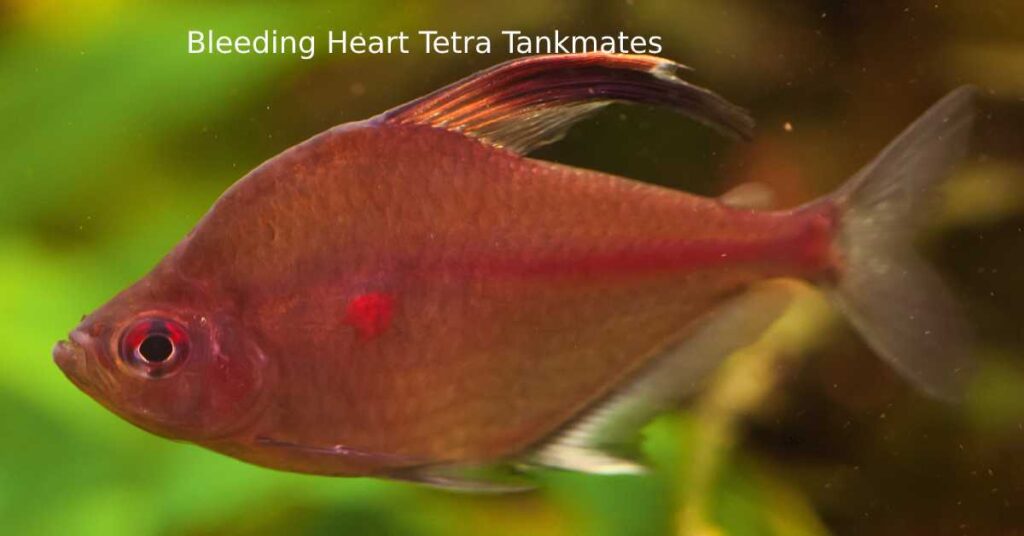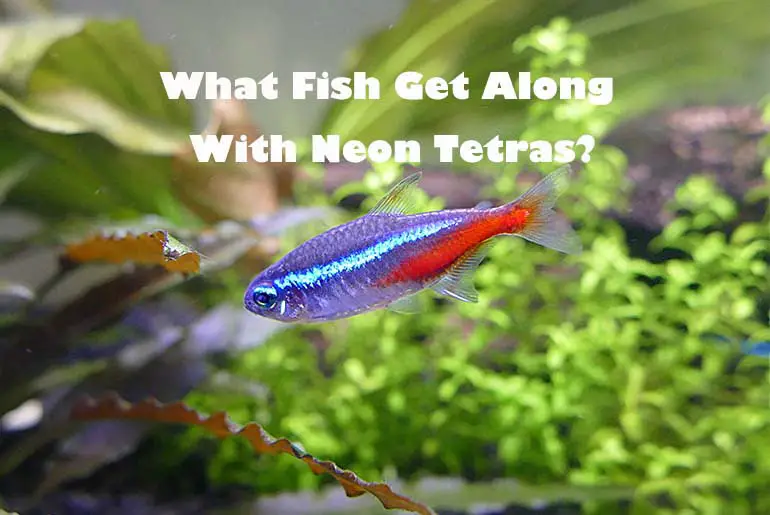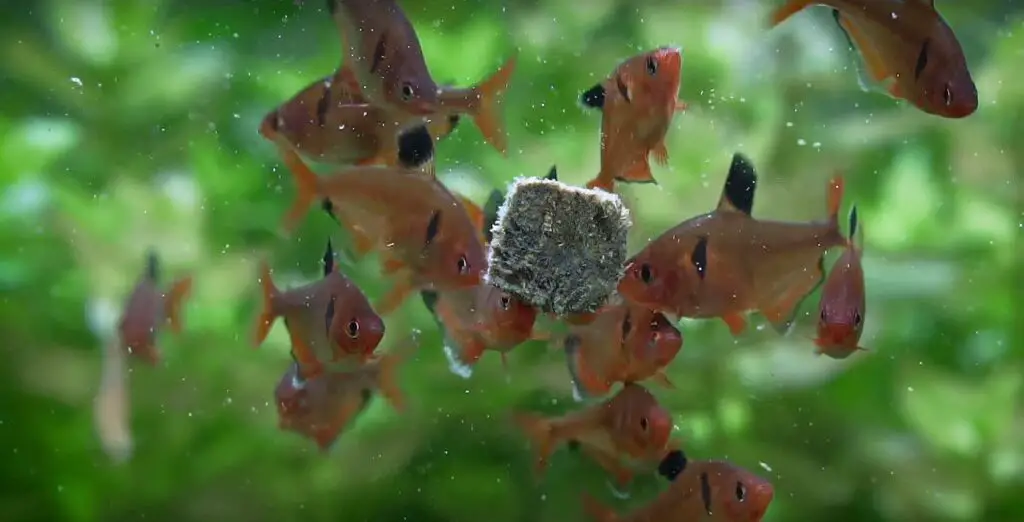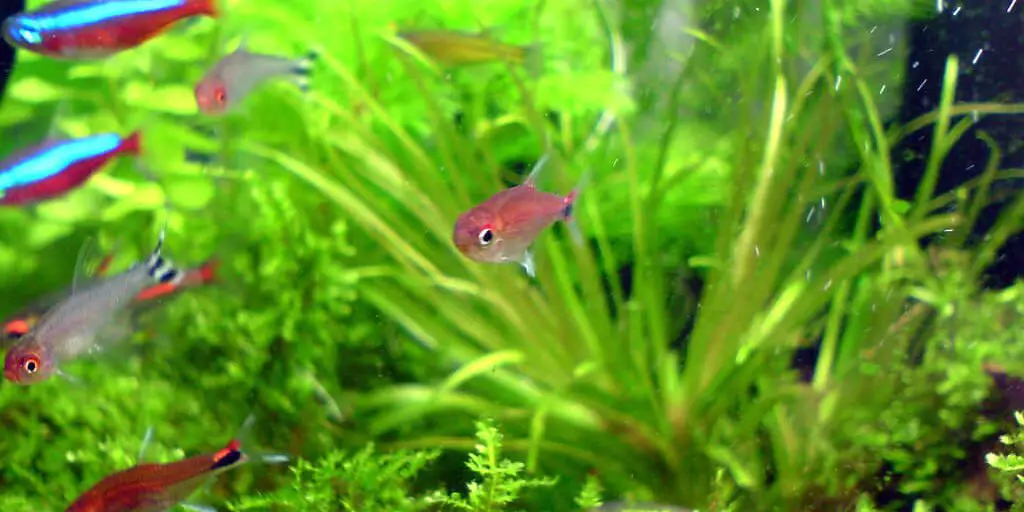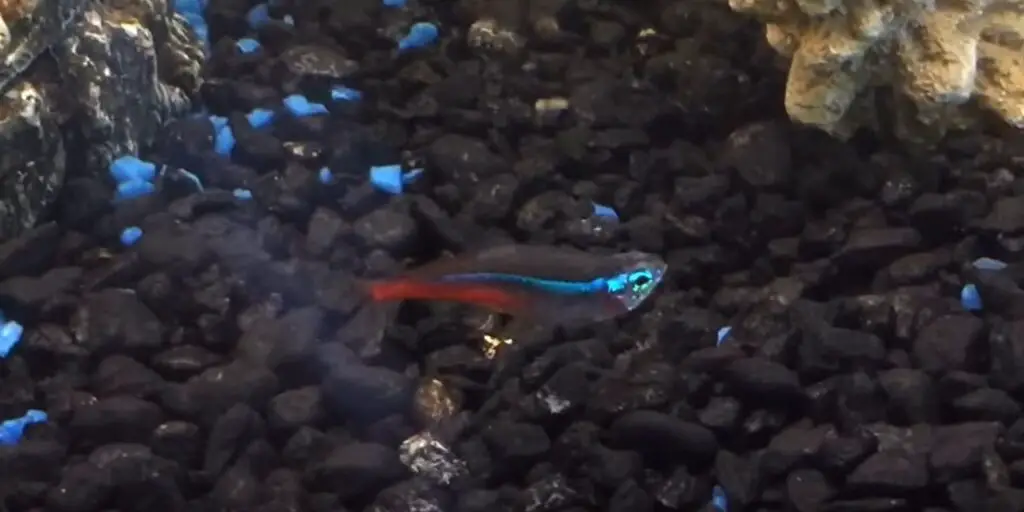Are you someone who loves bleeding heart tetras but is unsure about looking after them correctly? If yes, then do not worry! This article is for you. Here, you will learn about bleeding heart tetras more precisely, which will help you care for them better. Also, I will be helping you to know about the most asked question, does Bleeding Heart Tetra need tankmates or not?
Yes, bleeding heart tetras need tankmates since they can experience loneliness or feel isolated without them. Bleeding heart tetras may not adapt to any environment where there are no other fish as their tankmates. So, you have to add suitable tankmates for this tetra. Goldfish, guppies, neon tetra, danios, and harlequin Rasboras can be suitable tankmates for bleeding heart tetra.
These fish are non-predator and also need the same water parameter and temperature range as bleeding heart tetra. Other best tankmates are Cory catfish, snails, crabs, and loaches, sound company providers.
Besides, you also have to be careful about tank condition, temperature, water parameters, food, diet, and many more for the bleeding heart tetras and their tankmates.
Before going on to the main topic of this article, I want to start with a chart representing the characteristics of bleeding heart tetra.
Characteristics: A Quick Review On Bleeding Heart Tetra
Here are the characteristics and aquarium care of bleeding heart tetra.
| Aquarist Experience Level | Beginner |
| Size Of Fish | 3.5 inches |
| Minimum Tank Size | 30 Gallons |
| Temperament | Peaceful |
| Diet | Omnivorous |
| Color Form | Beige Orange To Silvery Lavender |
| Aquarium Hardness | Moderately Hardy |
| pH | 6.0 to 6.5 (Slightly acidic) |
| Temperature | 72°F to 80°F (around 75°F is ideal) |
Does Bleeding Heart Tetra Need Tankmates?
Yes, bleeding heart tetras need tankmates because they tend to be happier and more active when they are around tankmates.
These charming tetras are community fish who can often stress out if they find themselves alone in any area.
So, after you buy this tropical fish, you are likely to add varieties of tankmates as soon as possible.
Reasons Why Bleeding Heart Tetra Needs Tankmates
Let me give you three more firm reasons why bleeding heart tetra needs tankmates.
- The presence of tankmates can make bleeding heart tetra feel at ease and secure hence these tetra can show the best colors when they feel secure.
- Bleeding heart tetras or any other fish have natural eavesdropping capacity, which helps them to monitor and feel the presence of others. So, when they feel the presence of tankmates around them, they tend to become comfortable and happier.
- Bleeding heart tetras can be prone to nipping if kept alone or with less number of tankmates. So, to reduce the nipping, they must be kept in large schools.
Not to forget, bleeding heart tetra needs tankmates, but that does not mean you will end up adding loads of fish.
Since overcrowding tanks with heaps of tankmates can cause suffocation for these tetras. Bleeding heart tetra has nervous systems that help them react to stimuli when fish and species are overcrowded.
Above all, congestion or overcrowding results in the death of your tetra because of irritation and other health issues.
Tips For Selecting Tankmates For Bleeding Heart Tetra
You cannot place bleeding heart tetras with any fish you like, as you must carefully pick the tankmates.
Let me give you tips about what you can look for in perfect tankmates and what you should ignore.
- Do not go for the aggressive fish community.
- Look for freshwater fish since bleeding heart tetra also falls under the freshwater category.
- Avoid fish with large and sharp fins.
- Keep away bleeding heart tetras from bigger-sized fish as they can stress them.
- Select fish that requires similar water parameters as your tetra.
- Bottom feeders are a good choice to consider as a tankmate for bleeding heart tetras.
- Avoid fast-moving fish since they can outcompete their tankmates for food and space.
- Pick small schooling, peaceful, and friendly type of fish and species.
12 Best Tankmates For Bleeding Heart Tetra
Bleeding heart tetra admires peaceful and active tankmates. They are fond of playing with their tankmates to reduce stress and to be more playful.
Likewise, these tetras are non-predators who cannot harm or prey on another fish. So, they can go with small and community fish.
Some fish may be compatible, and some might be non-compatible for bleeding heart tetras. But the vital thing to keep in mind is you should avoid keeping these tetras with predatory and aggressive groups of fish.
So, you have to choose tankmates with good natures, such as non-territorial, non-predators, non-aggressive, and supportive.
Let me give you a list of some fantastic fish as a tankmate for bleeding heart tetras.
Cherry Barbs
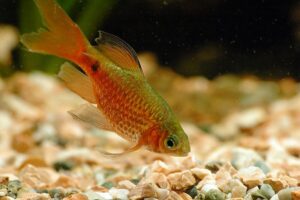
Cherry Barb is a slender type of fish that is small in size. So, this fish does not require a lot of room in the aquarium.
These fish are community fish that can add spark to your aquarium with their brilliant bright body color.
The tank where you are planning to keep bleeding heart tetra and cherry barbs together must be big-sized.
It is because both of them are social fish, and they like being together in large schools. So, you can place five to ten cherry barbs with bleeding heart tetras in a big gallon tank. (at least 30 gallons capacity or more).
| Size | 2 inches max |
| Temperament | Peaceful |
| pH | 6 to 8 |
| Temperature | 73 °F to 81 °F |
Cherry barbs also do not like being alone on their own, like bleeding heart tetras, and they enjoy the company of their tank mates.
It can be a great idea to place them together without any problem. These barbs are quiet fish that do not hamper their tank mates’ peace.
Likewise, feeding cherry barbs is not difficult since they can eat the same food items like frozen peas, broccoli, salmon, carrots, and other plant items you give to bleeding heart tetra.
Rasboras
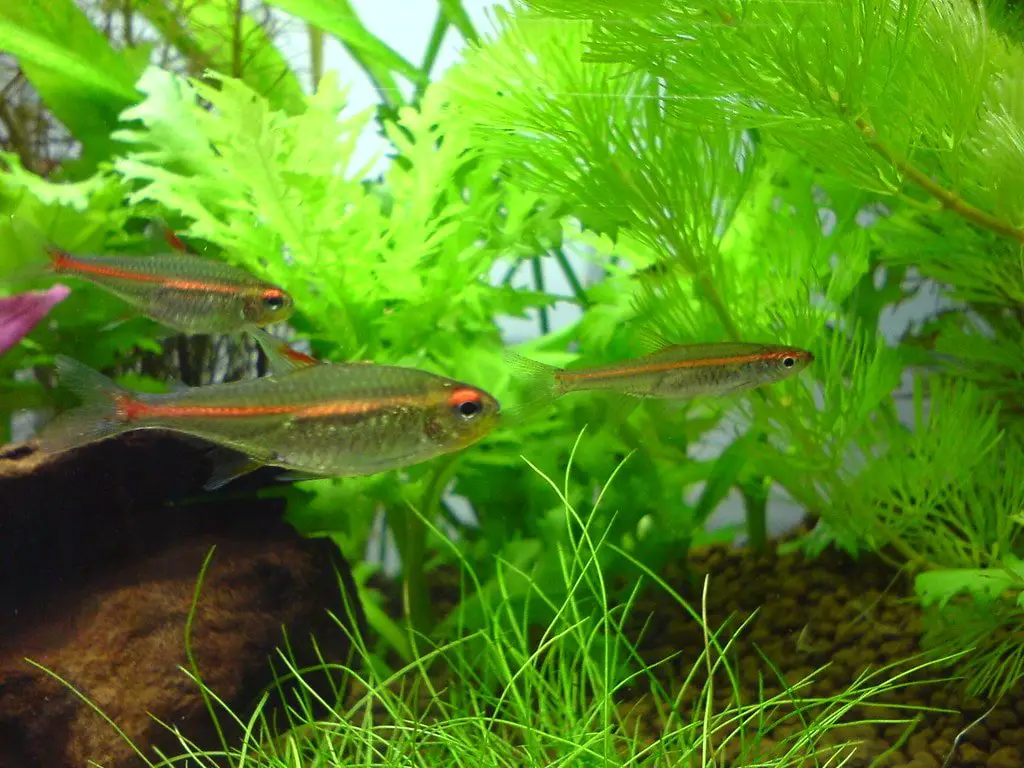
This tropical fish also eats the same food diet as bleeding heart tetra. So, they are best for each other.
Both of these fish need someone to be around as it makes them feel restful and secure. Rasboras is a non-carnivore and non-predatory fish.
So, they do not hunt other fish, and it is safe for you to keep them with bleeding heart tetras.
| Size | 1.5 inches max |
| Temperament | Peaceful |
| pH | 5 to 7 |
| Temperature | 70 to 85 °F |
Rasboras can be a bit aggressive sometimes, only if you do not care for them properly. However, this fish is mild, energetic, calm, and quiet and helps their friends to be more playful and enthusiastic.
Rasboras have the same energy level as bleeding tetra, as both of them like to spend most of the time playing behind plants and other playing spots like caves, driftwood, and tunnels.
This fish makes bleeding heart tetra feel safe and provides a secure- company. So, you can go for Rasboras as an ideal tankmate for bleeding heart tetras.
Zebra Loaches
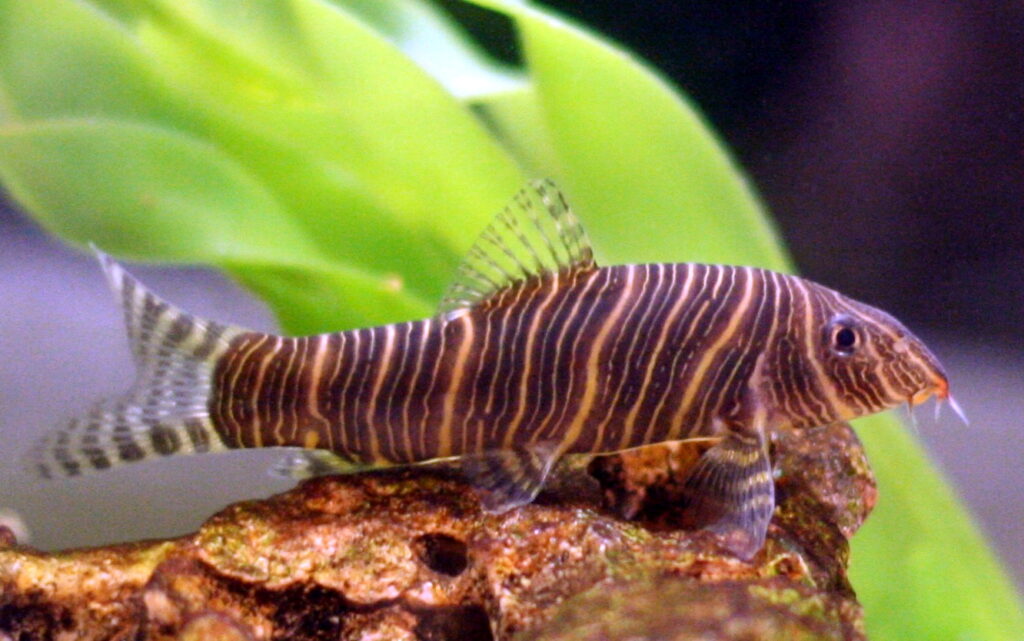
If you’re looking for an adorable aquatic companion that won’t take up too much space in your tank, you might want to consider the zebra loach. These little swimmers are experts at staying low and hanging out near the bottom of the tank, but don’t let their size fool you.
Despite their diminutive stature, zebra loaches are known to be fantastic teachers and mentors to other fish in the tank. Plus, they’re a friendly bunch – they won’t hunt or chow down on their tankmates, so they’re perfect pals for community fish like the bleeding heart tetra. So why not add a zebra loach to your aquarium family and watch the magic unfold?
| Size | 3.5 inches max |
| Temperament | Peaceful |
| pH | 6 to 8 |
| Temperature | 59-77°F |
These versatile swimmers are built to withstand a range of different water conditions, making them perfect roommates for all sorts of fish. Plus, they’re not picky eaters – zebra loaches are happy to munch on whatever they can find at the bottom of the tank, from old food scraps to organic matter to algae. But what really sets these fish apart is their gentle nature.
Unlike some of their more spiky-finned peers, zebra loaches won’t poke or prod their tankmates, making them perfect pals for community fish like the bleeding heart tetra. So if you’re looking for a low-maintenance addition to your aquarium, consider adding a zebra loach or two – your other fish will thank you for it!
Dwarf Neon Rainbow
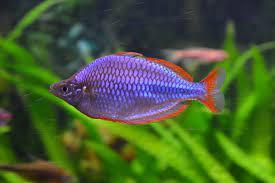
Dwarf neon is schooling freshwater fish. Undoubtedly, they feel happy if you keep them in large schools.
If you’re looking for a cheerful and colorful addition to your aquarium, look no further than the dwarf neon rainbow fish! These petite tropical swimmers are happiest when they’re part of a large school, so make sure to give them plenty of company if you decide to add them to your tank.
Fortunately, these little fish are easy to please – they prefer the same water conditions and tank setup as bleeding heart tetras, and they’re happy to hang out at the surface level of the water. Caring for them is a breeze – you can treat them just like your beloved bleeding heart tetras.
| Size | 3 inches |
| Temperament | Peaceful |
| pH | 6.8 to 7.5 |
| Temperature | 73 to 82°F |
What really sets these fish apart, though, is their friendly and accommodating nature. Not only are they compatible with a wide range of invertebrates like crabs and snails, but they also have a striking color and an incredible schooling behavior that’s sure to brighten up any tank.
So if you’re looking for a fun and low-maintenance tankmate for your bleeding heart tetras, consider adding some dwarf neon rainbow fish to your aquarium – they’ll fit right in!
Mosquito Rasboras
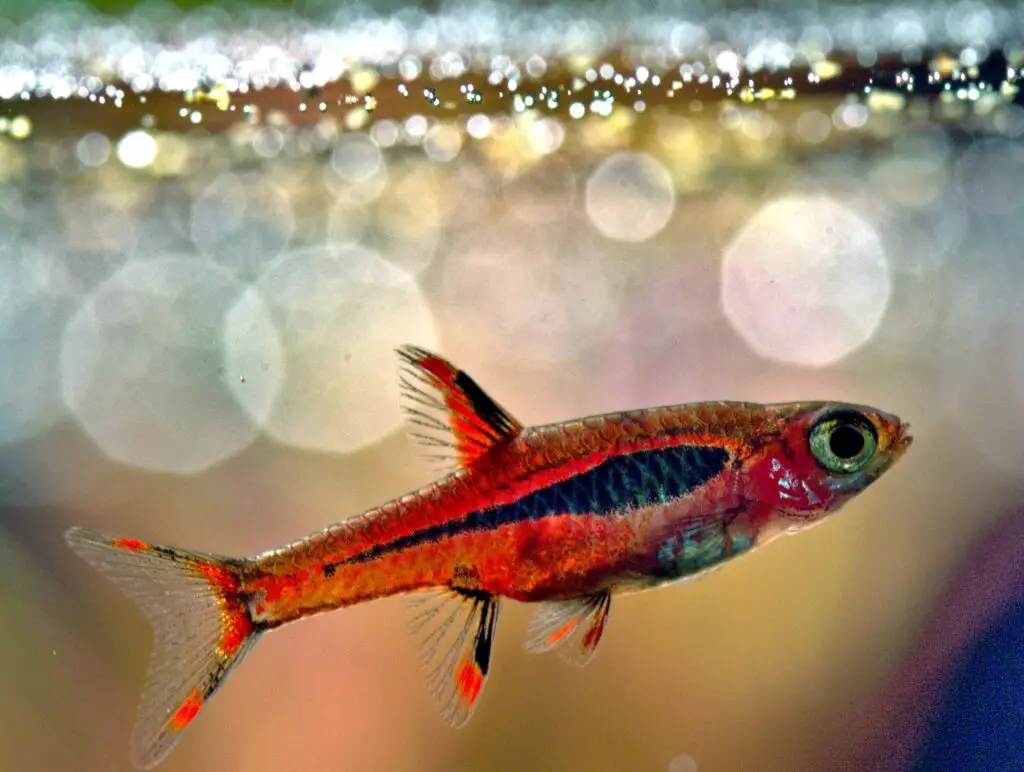
Mosquito Rasboras is shy and does not bother or disturb any of their tankmates. These Mosquito Rasboras are best at giving company to any fish or species.
They form the perfect school in the tank if they are kept in the big-sized tank with compatible tank mates.
They do not like being isolated and alone as they love thriving in large schools with varieties of tankmates.
| Size | 3 inches |
| Temperament | Peaceful and friendly |
| pH | 4 to 7 |
| Temperature | 70-82.4° F |
Mosquito Rasboras are easygoing fish that will happily swim most of the day and are fun to watch. They are non-territorial, slow movers, and incredibly peaceful.
This rasbora is tiny, like shrimp, and they do not have aggressive behaviors. Due to these reasons, you can keep them with bleeding heart tetras.
Corydoras
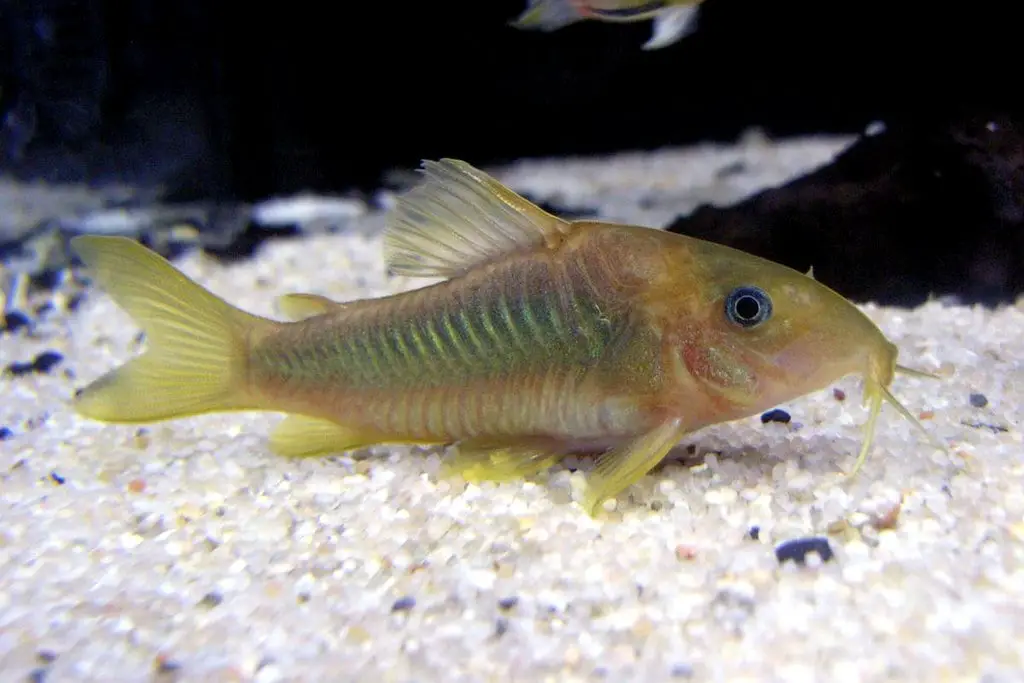
Looking for a catfish that’s both easy-going and hardy? Look no further than the Corydoras! Thanks to their calm and peaceful temperament, these freshwater fish are the perfect addition to any community tank. But what really sets them apart is their social nature – while they can certainly live alone, Corydoras are happiest when other fish breeds and invertebrates surround them.
| Size | Around 2.5 inches |
| Temperament | Peaceful and pleasant |
| pH | 7 to 8 |
| Temperature | 60 to 75 ° F |
Fortunately, these sociable swimmers are perfectly compatible with another popular fish breed: the bleeding heart tetra. These quick-moving fish swim in the middle range of the tank, while Corydoras are slow and steady swimmers who stick to the bottom. That means there’s no competition for food or space, and both breeds can thrive in the same water parameters and temperature.
If you’re looking for a duo that will get along swimmingly, consider adding some Corydoras to your aquarium alongside your bleeding heart tetras. With their hardy nature and friendly demeanor, these catfish are sure to be the perfect tankmates for your beloved fish.
Whiptail Catfish
If you’re on the hunt for a community fish that’s both sociable and visually striking, look no further than the whiptail catfish! These fish thrive when kept in pairs or alongside other varieties of fish, making them the perfect addition to any community tank.
One thing these catfish particularly love? Tall plants! Adding tall plants to your aquarium can make whiptail catfish feel right at home, providing them with ample opportunities to play and hide.
And when it comes to feeding, whiptail catfish are as low-maintenance as they come – just like the bleeding heart tetras they’re often paired with, these omnivores will happily dine on just about anything, including algae, plants, meat, and homemade fish food.
| Size | Around 4 inches |
| Temperament | Calm |
| pH | 6.0 to 7 |
| Temperature | 72 to 70° F |
Similarly, these catfish are fast movers like bleeding heart tetras and swim in the middle range.
With their stunning appearance and easy-going nature, whiptail catfish is a great choice for any aquarium enthusiast looking to add a little extra color and personality to their tank. So why not consider bringing a few of these friendly fish home and watch them thrive in your aquarium?
Zebra Danios
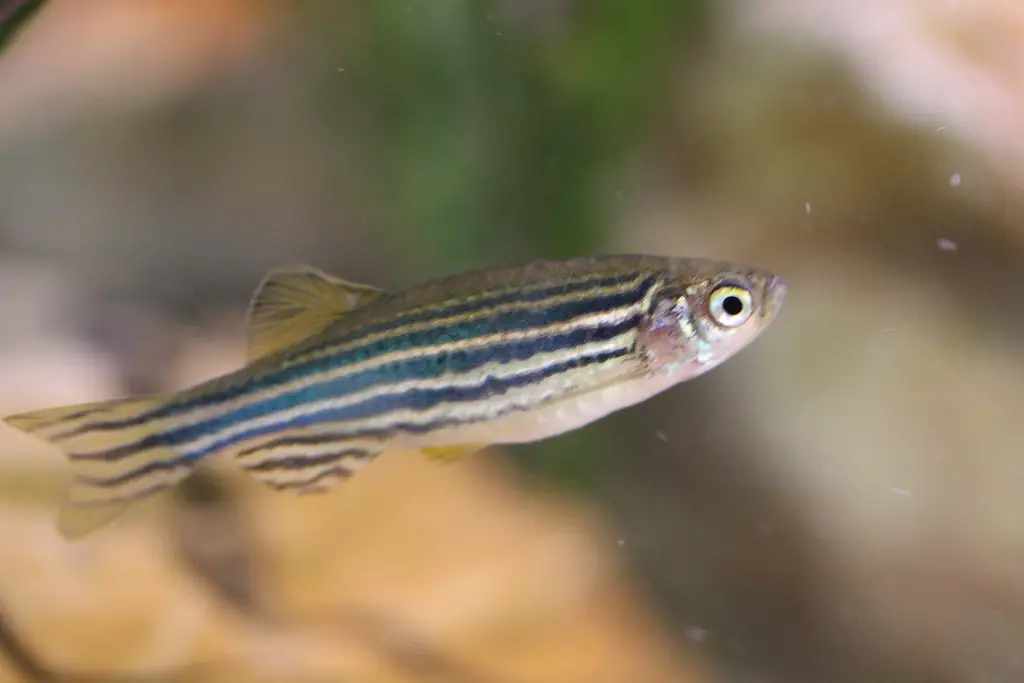 Zebra danios are popular freshwater fish that are beloved by aquarium enthusiasts around the world. With their striking black and white stripes, these small fish are a visual treat, adding a pop of color and personality to any tank. But what really sets zebra danios apart is their energetic and playful nature. These fish are known for their darting movements and love of exploring every nook and cranny of their environment.
Zebra danios are popular freshwater fish that are beloved by aquarium enthusiasts around the world. With their striking black and white stripes, these small fish are a visual treat, adding a pop of color and personality to any tank. But what really sets zebra danios apart is their energetic and playful nature. These fish are known for their darting movements and love of exploring every nook and cranny of their environment.
| Size | Around 2 inches |
| Temperament | Peaceful and shy |
| pH | 7 to 7.8 |
| Temperature | 70° and 78° F |
Zebra danios have unique characters in case of being divine friends as these tropical fish are not aggressive, and you can easily keep them with your tetra.
These fish like to travel in groups once they are comfortable in their new home with their tank mates.
Zebra danios also need the same water parameters as bleeding heart tetra, which means they can be kept together.
Platies
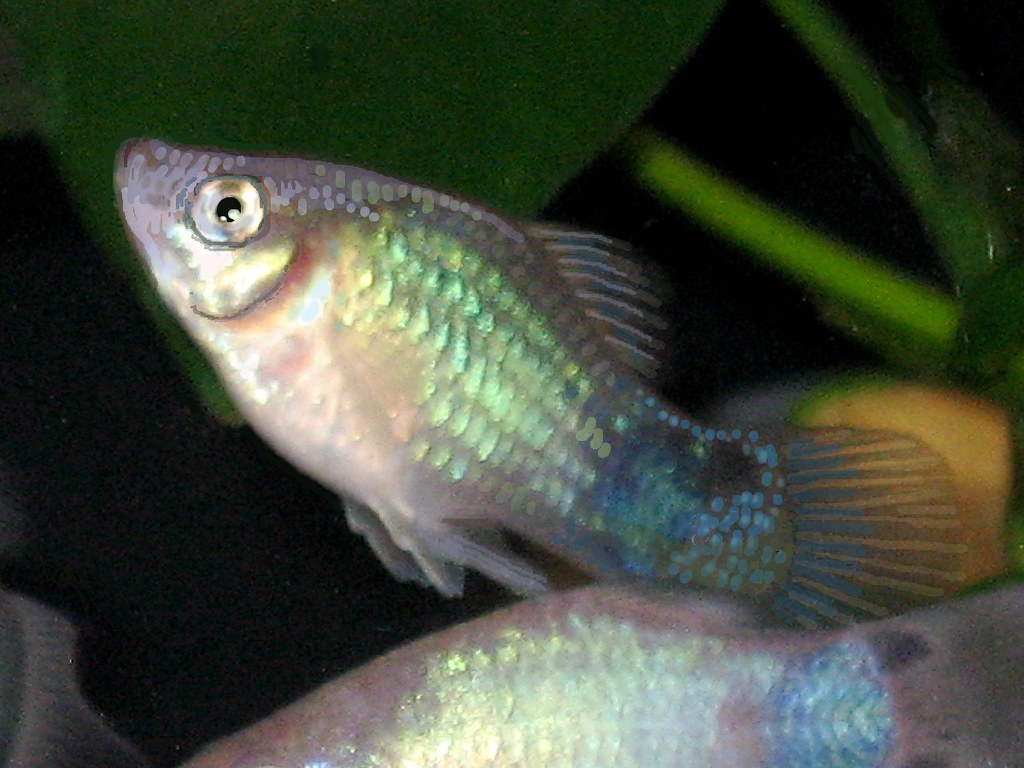
Platies fish are perfect for beginners as it is easy to look after them. They are peaceful in nature and also demand peaceful tankmates.
Platies are fantastic jumpers who can leap out of your tank. So, make sure you add a secure lid to your tank.
| Size | Around 2.8 inches |
| Temperament | Peaceful and shy |
| pH | 6.8 to 8.0 |
| Temperature | 70-82°F |
Meet the platy – a colorful and charming tropical fish that’s native to the warm waters of South America. These fish thrive in mild currents and love living in large schools, making them the perfect companion for your beloved bleeding heart tetras.
But what really makes platies stand out is their easy-going nature when it comes to food. Whether you’re feeding them green veggies, meaty treats, or simple flakes, these non-fussy eaters will happily chow down on just about anything you give them.
And with their peaceful and friendly temperament, they’re the perfect choice for anyone looking to add a touch of harmony and tranquility to their aquarium.
Dwarf Cichlids
Dwarf cichlids are not very active swimmers. So, they do not need a lot of space in an aquarium. These fish do well with their tankmates as they are calmer, friendly, and peaceful in nature.
| Size | Around 2 inches |
| Temperament | Peaceful |
| pH | 7.0 to 7.5 |
| Temperature | 23 to 28°C |
This cichlid may not get along with big and aggressive fish like angelfish, kissing gourami, Bala sharks, and killifish.
However, it can easily and happily live with peaceful fish like bleeding heart tetras, platies, mollies, neon tetras, goldfish, and other tetras.
Dwarf cichlids are hardy fish and are easy keepers that will eat frozen peas, broccoli, small pellets, and other food items.
Providing them with tall artificial plants can also be a good idea so that there will be a handful of spots for them to hide and play with their tank mates.
Amano Shrimp
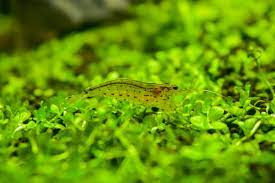
Amano shrimps are algae eaters who love highly planted tanks. This shrimp is a great swimmer who prefers soft to moderate water.
| Size | 2 inches max |
| Temperament | Peaceful |
| pH | 6.0 to 7.0 |
| Temperature | 70 – 80 °F |
Amano shrimp pairs very well with bleeding heart tetras due to their friendly behavior. This shrimp is also very popular among aquarists as they are very easy to care for and keeps a good check on algae, organic matter, and food debris.
Amano shrimp are omnivores who can consume varieties of plants and meat items. As they eat anything off the substrate, ensure you only add a limited amount of food not to overfeed them.
Moreover, their matching water parameter and bottom-dwelling make them ideal tankmates for your tetra.
Other Bleeding Heart Tetras
Without a doubt, you can add bleeding tetras as tankmates with other bleeding heart tetras.
These tetras are schooling fish, and you should never keep them on their own without companions of fish and species.
So, you have to keep bleeding heart tetras in schools of at least six fish or more. This is the only way that can help you to see their natural color and behavior.
As they are both the same species with peaceful and calm temperaments, there is nothing to worry about in terms of territory, size, food, and many more.
Other Possible Tankmates
Bleeding heart tetras love to live and play with fish of their size or smaller than them who do not have large and sharp fins to nip. So, the possible other tankmates for bleeding heart tetra are as follows:
- Cory
- Neon Tetras
- Lemon Tetra
- German Blue Ram
- African giant filter shrimp
- Guppies
- Crabs
- Snails
- Shrimps
Community Fish Types Not To Keep With Bleeding Heart Tetra
Tankmates can be good or bad depending on their nature and breed. For bleeding heart tetras, you have to go for peaceful, small, and joyful fish.
Avoid adding fish species that are larger than bleeding heart tetra. Since bleeding heart tetra is small, and it needs to be placed with small ones while schooling.
Here are some types of community fish you shouldn’t keep with your tetra:
Predators
Predatory fish groups such as jewel cichlids, serums, rainbow sharks, bichir, and the red devil cichlids shouldn’t be kept with bleeding heart tetras. It is because they can end up making your tetra prey.
Chasers
Similarly, some fish, such as flower horn cichlids, bucktooth tetra, tiger barbs, kissing gourami after knife, and convict cichlids can trick anyone with their attractive look. Still, these fish can bully their tankmates to death by attacking and chasing them all day long.
Aggressive Ones
Aggressive fish like angelfish, fancy goldfish, Bala shark, clown loaches, Texas cichlids, and tiger barb can hurt their tankmates with their pointed and sharp fins.
Similarly, these fish also cannot get along with their tankmates due to their aggressive behavior.
So, these activities can make their tankmates feel unhappy and unsafe. Therefore, I want you to avoid these fish breeds for your tetra.
Short Remainder To Keep In Mind
First, before you are excited to keep bleeding heart tetras with other tankmates, I suggest you not initially put your tetra and those tank mates that you have chosen together.
First, separately store the rest of the tank mates and observe their activities. After you keep tankmates together, you can make them familiar with one another, and then you can add bleeding heart tetras at last.
You should keep the other tankmates together at first because there will be less chance of aggression and fighting in the tank.
Frequently Asked Questions
Here are answers to some FAQs you might prefer getting answers to.
Do Bleeding Heart Tetra Live With Other Tetra?
Yes, bleeding heart tetra can live with other tetras since tetras are also schooling fish as bleeding heart tetra.
Both of these tetras need the same water parameters and temperature. Bleeding heart tetra and tetra are compatible with forming a large school in the tank.
Bleeding heart tetras do well with tetras like rummy nose tetra, cardinal tetra, and neon tetras.
Tetra and bleeding heart tetras are freshwater divers who can easily survive in the freshwater inside your tank.
You might like to read more about Tetra Fish Care and 47 Types of Tetra Fish [From A to Z] | A Complete Tetra Species Guide.
Should I Keep Goldfish And Bleeding Heart Tetra Together?
Yes, you can keep goldfish and bleeding heart tetra together, both of them like swimming in slow-moving water.
Likewise, bleeding heart tetras and goldfish swim in the lower as well in the middle range of water.
Goldfish are also peaceful as bleeding heart tetra. Generally, both of these freshwaters can go along if you care appropriately. Overall, goldfish is a pleasant and quiet fish.
Can Bleeding Heart Tetra And Betta Go Along?
Yes, bleeding heart tetra and bettas can go along. However, you also have to be cautious as bleeding tetra fish can open their nippers if they feel suffocated, which may harm bettas.
Also, bettas can get a bit frustrated if they have to deal with the nippers. However, bleeding heart tetras do not affect bettas.
Since this fish can swim most in the lower water level while bleeding heart tetras swim in the middle range of water, so, both of them cannot get in their way.
Is Bleeding Heart Tetra Aggressive?
Bleeding heart tetras are lovely and peaceful freshwater fish. Nevertheless, this tetra can be aggressive if kept alone.
So, schooling is necessary. If you keep bleeding heart tetras alone in the tank, they can feel lonely and angry.
Bleeding tetra is schooling fish; they need mates to feel secure and happy. So, you have to place this tetra with large schools of at least six or more individuals.
To Sum Up
Bleeding heart tetras are incredible grouping fish that tends to be very tempting and beneficial as they are adequate tankmates for species, fish, and invertebrates. At first, it can be a bit challenging for housing purposes. Nonetheless, once you know what tankmate to keep for bleeding heart tetra, then it can be productive and easy.
Remember, bleeding heart tetra is hardy, but it does not mean they will be happy in an unclean and overstocked tank. So, make sure you clean your tank. Also, if you are creating a community tank with bleeding heart tetra, only add a limited and right number of tankmates for them. I know it can be confusing to choose the right tankmate.
But you can choose the ideal fish and invertebrates I have mentioned above for your tetra. Not to forget, ensure you also maintain the correct water parameters for the bleeding heart tetra and its tank mates.
Good Luck!!!
Happy And Healthy Fish Keeping!!!
Recommended Articles:
- 12 Best Tetra Fish Tank Mates And Fish To Avoid
- Neon And Cardinal Tetra Tank Mates – Compatible Tank Mates
